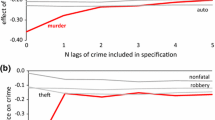Abstract
A model of the crime deterrence process is formulated based on the assumption that the objective of the police in allocating resources among various programs is to minimize the social losses from crime. The independent deterrent effects of two such programs, patrol and investigation, are analyzed using linear regression analysis and employing data, from police departments in the Los Angeles region. The results support the hypothesized deterrence process and show that, while separate deterrent effects are important, extensive complementarity also exists between patrol and investigation. In addition, it is found that the most cost-effective law enforcement policies for curbing urban crime are those that merely redeploy existing police resources but that social policies, especially those aimed at reducing poverty, are also important alternatives.
Similar content being viewed by others
References
Becker, G. (1968) “Crime and Punishment: An Economic Approach,”Journal of Political Economy, vol. LXXVI (March–April): 169–217.
Carr-Hill, R. A. and N. Stern (1973) “An Econometric Model of the Supply and Control of Recorded Offenses in England and Wales,”Journal of Public Economics (November): 289–318.
Chapman, J. (1976) “An Economic Model of Crime and Police: Some Empirical Results,” Journal of Research in Crime and Delinquency, Vol. 13 (January).
Ehrenberg, R. (1973) “The Demand for State and Local Government Employees,”American Economic Review, Vol. LXIII (June): 366–80.
Ehrlich, I. (1973) “Participation in Illegitimate Activities: A Theoretical and Empirical Investigation,”Journal of Political Economy, Vol. LXXXI (May–June): 521–65.
Fleisher, B. M. (1966) “The Effect of Income on Delinquency,”American Economic Review, Vol. LVI (March): 118–38.
Greenwood, M. J. and W. Wadycki (1973) “Crime Rates and Public Expenditures for Police Protection: Their Interaction,”Review of Social Economy (October): 138–151.
Maltz, M. D. (1972).Evaluation of Crime Control Programs. Washington: U. S. Department of Justice, LEAA.
Mathur, V. K. (1976) “A Factor Analysis of Socioeconomic Determinants of Property Crimes in Cities,”Annals of Regional Science, Vol. X (July: 116–127.
McPheters, L. and W. Stronge (1974) “Law Enforcement Expenditures and Urban Crime,”National Tax Journal, Vol. 27 (December): 633–44.
Orsagh, T. (1973) “Crime, Sanctions and Scientific Explanation,”Journal of Criminal Law, Criminology and Police Science, Vol. 64 (September): 354–61.
Palmer, J. (1977) “Economic Analysis of the Deterrent Effect of Punishment: A Review,”Journal of Research in Crime and Delinquency, Vol. 14 (January).
Pogue, T. (1975) “Effect of Police Expenditures on Crime Rates: Some Evidence,”Public Finance Quarterly: 14–45.
Press, S. J. (1971).Some Effects of an Increase in Police Manpower in the 20th Precinct of New York City. New York: New York City-Rand Institute.
Shoup, D. and S. Mehay (1972).Program Budgeting for Urban Police Services. New York: Praeger.
Sjoquist, D. (1973) “Property Crime and Economic Behavior: Some Empirical Results,”American Economic Review, LXIII (June): 439–47.
Swimmer, E. (1974) “Measurement of the Effectiveness of Urban Law Enforcement-A Simultaneous Approach,”Southern Economic Journal, Vol. 40 (April): 618–30.
Thaler, R. (1977) “An Econometric Analysis of Property Crime,”Journal of Public Economics, Vol. 8, pp. 37–51.
Urban Institute and International City Management Association (1974).Measuring the Effectiveness of Basic Municipal Services. Washington, D.C.
U. S. Department of Justice, F.B.I., Uniform Crime Reports, annual.
U. S. President's Commission on Law Enforcement and Administration of Justice (1967) Task Force Report;Crime and Its Impact--An Assessment. Washington, D.C.: USGPO.
Votey, H. and L. Phillips (1975) “Police Effectiveness and the Production Function for Law Enforcement,”Journal of Legal Studies.
Weicher, J. C. (1970) “The Effect of Income and Delinquency: Comment,”American Economic Review LX (March): 249–56.
Wilson, J. Q. (1968).Varieties of Police Behavior. Cambridge, Mass: Harvard University Press.
Author information
Authors and Affiliations
Rights and permissions
About this article
Cite this article
Mehay, S.L. The deterrent effect of urban police services: Further results. Ann Reg Sci 13, 66–77 (1979). https://doi.org/10.1007/BF01284080
Issue Date:
DOI: https://doi.org/10.1007/BF01284080




